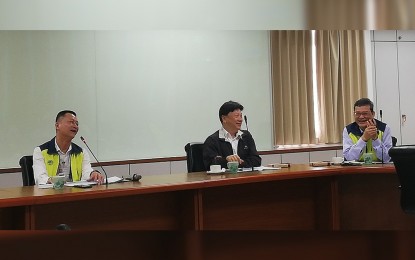
RENEWABLE ENERGY. Officials of Linkou Power Plant brief officials of the Manila Electric Company (Meralco) and Meralco Powergen Corporation (MGen) as well as Philippine journalists on the power plant's operations. From left to right: Plant General Manager Yun-Chung Chu, Deputy Plant General Manager Jyh-Guang Lee, and Deputy Plant General Manager Ru-Chin Chou. (PNA photo by Joann Villanueva)
TAIPEI, Taiwan -- Renewable energy’s (RE) contribution on Philippines’ total energy mix remains small, thus, it is working to increase such share to the overall supply, but the country is not alone on this effort, an official of a power station here said.
In a briefing here Tuesday, officials of Linkou Thermal Power Plant, which is part of the government-owned Taiwan Power Company (Taipower), said shares of RE on their total portfolio remain small at nearly 10 percent.
Linkou Power Plant Deputy Plant General Manager Ru-Chin Chou said the government has adopted three years ago a target to increase RE’s share to total portfolio to 20 percent by 2025.
To date, the bulk of Taipower’s generation capacity is accounted for by coal-fired power plants and combined-cycle power plants at 38 percent each, while the balance of 14 percent is accounted for by nuclear power.
In the Philippines, the Department of Energy (DOE) has earlier set a 30-30-30-10 share for coal, natural gas, renewables, and other sources like oil-based power generation plants.
DOE Secretary Alfonso Cusi earlier said that while this goal is good, he encouraged investors to finance any power project that will boost the country’s capacity.
He clarified that what is important now is to increase the capacity to ensure that the rising electricity requirements of the domestic economy is met.
President Rodrigo R. Duterte has also ordered the reduction of the country’s dependence on coal-fired power plants and increase on gas-fired and RE power plants.
To date, RE now accounts for about 32 percent of the country’s total power source.
Cusi also underscored the importance of consumer-oriented policies that would further advance the country’s RE sector since this is part of the DOE’s nine-point Energy Agenda.
He said measures continuously put in place since a few years back to boost the RE sector are slowly gaining ground as more investors are looking into placing their money in this sector.
Among the DOE policies towards this goal include the Green Energy Option Program (GEOP) and the Renewable Portfolio Standards (RPS).
An RPS for On-Grid Areas has been established as part of Republic Act (RA) 9513, or the Renewable Energy Act of 2008.
Under the RPS, distribution utilities (DUs) and retail electricity suppliers are required to source or produce at least a percent of the mandated participants’ supply that are part of their net electricity sales from eligible RE facilities.
RPS rules for off-grid areas vie to increase RE utilization to boost power supply mix in these areas that are normally served by diesel plants that have higher rates.
The RPR for this sector intends to rationalize the efficient use of universal charge for missionary electrification (UC-ME) and improve self-efficiency in power generation through the use of RE. (PNA)
